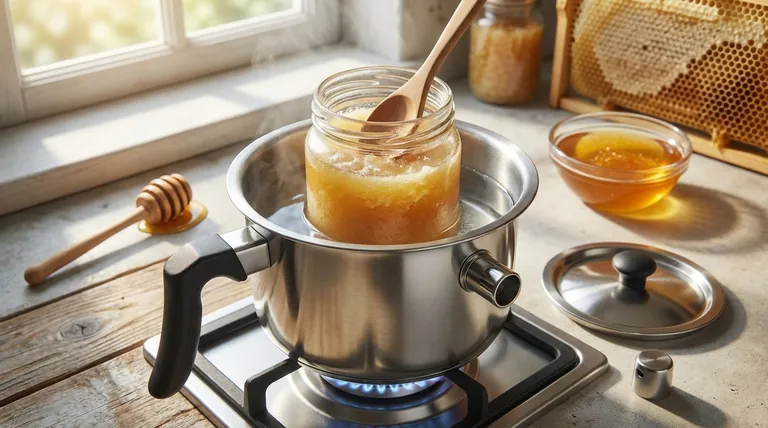The most effective way to re-liquify granulated honey is by gently warming its container in a bath of hot water. This carefully controlled process melts the glucose crystals that cause the honey to solidify, restoring its smooth, liquid texture without damaging its delicate flavor or beneficial properties.
Granulation is a natural sign of pure, unprocessed honey, not a sign of spoilage. The key to restoring its liquid state is applying gentle, indirect heat, as excessive temperatures from a stove or microwave can degrade its quality, flavor, and color.

Why Honey Granulates in the First Place
Understanding why honey solidifies is the first step to fixing it correctly. This is a completely natural phenomenon driven by the honey's composition.
A Natural Process, Not Spoilage
Granulation, also known as crystallization, is not an indication that your honey has gone bad. In fact, it's a hallmark of high-quality, pure honey that has not been over-processed.
The Role of Glucose
Honey is a supersaturated solution composed primarily of two sugars: glucose and fructose. Glucose has lower solubility than fructose, meaning it tends to solidify and form crystals, while the fructose remains liquid. The granulation you see is simply glucose separating from the water.
Triggers for Crystallization
The speed of granulation is influenced by the honey's specific floral source and its storage conditions. Cooler temperatures (below 50°F or 10°C) and the presence of tiny particles like pollen can accelerate the process by giving the crystals a starting point to form.
The Correct Method to Re-liquify Honey
The goal is to melt the glucose crystals slowly and evenly. The most reliable way to achieve this is with a gentle water bath.
The Stovetop Water Bath (Recommended)
This method gives you the most control for a consistent, safe result, especially for honey stored in a glass jar.
- Loosen the Lid: First, slightly loosen the lid of the honey jar. This allows for any pressure changes during warming.
- Prepare the Bath: Place the jar into a saucepan. Fill the pan with warm water until it comes about halfway up the side of the jar.
- Apply Gentle Heat: Place the pan on the stove over low heat. Do not let the water come to a boil.
- Stir Occasionally: As the honey warms, stir it gently. This helps distribute the heat and speeds up the process of dissolving the crystals.
- Remove When Liquid: Once the honey has returned to its liquid state, carefully remove the jar from the water and let it cool.
Critical Pitfalls to Avoid
How you heat the honey is as important as the heat itself. Aggressive heating methods will ruin the very qualities that make honey special.
Do Not Use the Microwave
Microwaving is the fastest way to damage your honey. It heats unevenly and far too quickly, creating super-heated spots that will caramelize the sugars. This permanently alters the flavor, darkens the color, and can destroy honey's natural enzymes.
Avoid Overheating on the Stove
Placing the honey directly in a pan or using high heat for the water bath is also a mistake. Excessive heat will degrade the honey's quality just like a microwave. The key is gentle, indirect warmth.
Be Cautious with Plastic Containers
If your honey is in a plastic container, be extremely careful. High heat can warp or melt the plastic. A very gentle water bath (using hot tap water, not stove heat) is the safest approach for plastic.
Making the Right Choice for Your Honey
Your approach should be guided by safety and the preservation of the honey's quality.
- If your primary focus is the safest, most effective result: Use the stovetop water bath method with a glass jar, keeping the heat low and stirring occasionally.
- If your honey is only slightly granulated or in a plastic bottle: Placing the container in a bowl of hot tap water is a simple and low-risk option, though it may take longer.
- If you want to preserve all the nuanced flavors and benefits: Always avoid the microwave and any form of direct, high heat.
By applying gentle heat, you can easily and safely restore your granulated honey to its perfect liquid state every time.
Summary Table:
| Method | Best For | Key Steps | Pitfalls to Avoid |
|---|---|---|---|
| Stovetop Water Bath | Glass jars, most effective result | Loosen lid, warm water, low heat, stir | Do not boil water or overheat |
| Hot Tap Water Bath | Plastic containers, slight granulation | Place jar in bowl of hot tap water | Avoid using stove heat with plastic |
| Methods to Avoid | All honey types | - | Never use a microwave or direct high heat |
For beekeepers and distributors, honey quality is paramount. HONESTBEE supplies the durable, high-quality beekeeping equipment—like stainless steel honey warmers and storage tanks—that commercial apiaries and distributors rely on to maintain product integrity from hive to shelf. Let's discuss your wholesale needs and how our supplies can support your operation. Contact HONESTBEE today!
Visual Guide

Related Products
- Beeswax Melter for Candle Making Honey Bee Wax Melter
- Electric Honey Press Machine for Squeezing Honey Comb Press Equipment
- 10L Stainless Steel Electric Honey Press Machine
- HONESTBEE 72 Frame Industrial Electric Honey Extractor for Beekeeping
- Steam Beeswax Melter Wax Warmer for Wax Processing
People Also Ask
- What is the flashpoint of beeswax? Essential Safety and Quality Tips for Beekeepers
- How do water jacket melters function? Achieve Gentle, Scorch-Free Melting for Sensitive Materials
- What makes polyurethane foam environmentally friendly? The Surprising Benefits of a Durable, Inert Material
- What do you use a wax melter for? From Home Fragrance to Professional Beekeeping
- What are the main types of wax melters? Choose the Right Heating Method for Your Needs



















